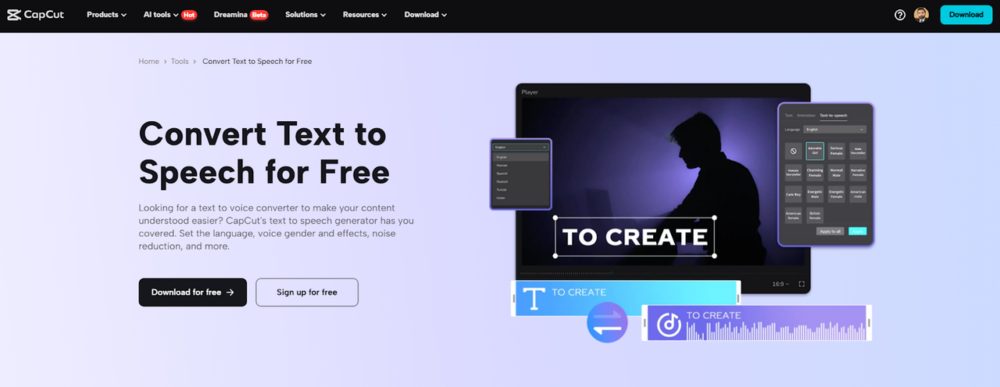The way people consume digital content has changed dramatically. Audio content is becoming a preferred choice, with millions tuning into podcasts, audiobooks, and voice-assisted devices daily. This shift has made repurposing blog content into audio a smart move for content creators, marketers, and businesses.
Converting blogs into audio expands content reach, making it accessible to more audiences. Some prefer listening over reading, while others benefit from accessibility features. This transformation is now easier than ever, thanks to text-to-speech technology. With the right video editing software, turning text into natural-sounding audio is seamless.

Why Convert Blogs into Audio?
Many audiences now favor audio over traditional reading. Here’s why converting blogs into spoken content is a game-changer:
- Reaching Listeners Who Prefer Audio Not everyone has time to sit down and read. Many people prefer listening to content while commuting, exercising, or doing daily tasks. Audio content allows multitaskers to absorb information conveniently.
- Enhancing Accessibility for Visually Impaired Users Converting blogs into audio makes content inclusive. Those with visual impairments or reading difficulties can engage with information effortlessly. Audio content helps bridge accessibility gaps and expands audience reach.
- Boosting Engagement and Retention People tend to remember audio content better than text. Spoken words create a more personal connection with the audience, increasing engagement and improving content retention.
- Expanding to Podcasts and Audio Platforms: Audio content can be repurposed beyond blogs. Converting blogs into podcasts, voiceovers, and social media clips enables content creators to reach audiences on different platforms, maximizing visibility and impact.
Choosing the Right Text-to-Speech Software for Blogs
The success of blog-to-audio transformation depends on choosing the correct text to speech software. Key features to consider include:
- Natural Voice Quality Select software with AI-driven voices that sound natural and human-like.
- Multiple Language Support Look for options that support various languages to expand global reach.
- Customization Options Fine-tune pitch, speed, and emphasis for better engagement.
CapCut Desktop text-to-speech feature is one of the best options for converting blog content into high-quality audio. It offers natural-sounding AI voices, multiple language support, and seamless integration with video editing software. Unlike traditional voice-over methods, which require expensive recording setups, CapCut Desktop simplifies the process with cost-efficient automation.
Optimizing Blog Content for Text-to-Speech Conversion
To ensure smooth text-to-speech conversion, optimizing blog content is crucial.
- Use a Conversational Tone Text that reads well may not always sound natural when spoken. Writing in a conversational style makes the audio more engaging.
- Avoid Complex Jargon Simplifying sentences and avoiding technical terms enhances clarity. Listeners should easily understand the content without confusion.
- Use Proper Punctuation Text-to-speech software relies on punctuation to dictate pauses and emphasis. Well-structured sentences improve the listening experience.
- Adjust Pauses and Emphasis CapCut Desktop TTS settings allow for adding pauses and emphasis, making speech sound more dynamic and expressive.
Enhancing the Audio with Effects and Music
A well-crafted audio blog should be engaging. Adding background music and sound effects improves the listening experience.
- Selecting Suitable Background Music Choosing subtle background music that complements the tone enhances the overall quality.
- Adjusting Speech Speed and Pitch Balancing speed, pitch, and volume creates a more natural and immersive audio experience.
- Using CapCut’s DesktopAudio Effects CapCut Desktop offers a variety of sound effects that can be integrated for added creativity and engagement.
How to Convert Text to Speech? – Step by Step
Step 1: Install CapCut Desktop and Start a Project
To begin, download and install CapCut Desktop from the official website. Once installed, open the software, sign in, and create a new project. If converting a blog into a video format, import the video file. Alternatively, enter text manually into the editor.
Step 2: Generate Text from Video or Input Manually
CapCut Desktop provides two methods for adding text: extracting text from a video or entering it manually. The AI caption generator automatically converts spoken words from a video into text. Alternatively, users can input text manually and customize font, placement, and color in the “Text” section.
Step 3: Apply AI Text-to-Speech and Adjust Voice Settings
Select the “Text-to-Speech” tool within CapCut Desktop. Choose from AI-generated voices, including different accents, genders, and tones. Adjust speech speed, pitch, and emotional tone to create a polished and engaging narration. CapCut Desktop also offers transition effects to enhance the video’s professional quality.
Step 4: Finalize and Export in Desired Format
Before finalizing, select an output format such as MP4 or WAV. Ensure the content is optimized for the intended platform. Verify copyright compliance before publishing. Once ready, export and share the audio content on social media, websites, or podcast platforms.
Conclusion
Converting blogs into audio content is a powerful way to enhance digital presence. It caters to diverse audiences, improves accessibility, and maximizes engagement. With tools like CapCut Desktop, the process is effortless. Its text-to-speech feature allows for high-quality, natural-sounding voiceovers without expensive equipment.
Repurposing written content into audio opens new opportunities. Whether expanding into podcasts or making content more inclusive, text-to-speech technology is a game-changer. Start integrating audio into content strategies today and reach a wider audience effortlessly.

Leave a Reply